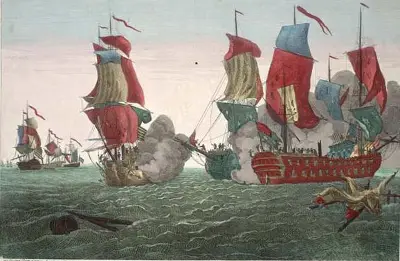John Paul Jones was a successful American naval commander who won a famous firefight and uttered one of the most famous quotes in American military history. Jones was born John Paul (without the Jones) on July 6, 1747, at Kirkbean, Kirkcudbright, in Scotland. His father was an estate gardener. He attended school until he was 12 and then gained an apprenticeship with a seaman. 
After a series of assignments, some of which carried slaves across the Atlantic, he got his own command. He was captain of the ship Betsy in 1773 when the crew mutinied, off the coast of Tobago, an island owned by Great Britain. In self-defense, he killed one of the crew. He took advantage of a warning of impending trial for the death and fled to the American colonies. He arrived in Philadelphia and soon after offered to serve with the Continental Congress. It is about this time that he added Jones to his name. The Continental Navy was in its infancy, and Jones got an assignment as first lieutenant aboard the first commissioned ship, the Alfred. He soon gained his own command, of the Providence, and then of a squadron, which contained the Alfred. The Providence was a powerful ship, with 21 guns. Jones captured 16 British ships. In June 1777, with the Revolutionary War on, Jones took up the assignment of overseeing the construction of a new large warship, the Ranger, which he was to command. He set sail aboard that ship in November. He sailed to France and conferred with officials there, including the U.S. Ambassador, Benjamin Franklin. After that conference, Jones set about harassing the British closer to their home. The idea was to convince the British to bring some of their ships back across the Atlantic, easing the pressure on the Continental Army in America. It was during one of these raids that Jones completed the first capture of a British warship, the Drake. Flush with success, Jones went back to France with the promise of being captain of an even larger ship. The Ranger had 18 guns. His new ship, a French commercial ship that had been converted to a 42-gun warship, was the Bonhomme Richard (named for Franklin). A five-ship squadron with Jones's new ship as the flagship left France in August 1779. It wasn't long until this new large warship saw action. It was on September 23 that Jones's squadron engaged in a firefight with two British warships, the HMS Countess of Scarborough and the HMS Serapis. As it turned out, four of the American ships engaged the 22-gun Countess of Scarborough, leaving Jones alone to fight the 50-gun Serapis. 
It was during this battle that Jones uttered his famous quote. After three hours of firing potshots and trying to outmaneuver each other, Jones ordered his ship to ram the Serapis and then tie the two ships together. For nearly two hours, the ships pounded each other with cannon fire. At one point, the Serapis captain, Richard Pearson, asked Jones if he was ready to surrender. Jones responded, "I have not yet begun to fight!" The four ships were more than enough to capture the Countess of Scarborough. By contrast, Jones and the Bonhomme Richard took an incredible pounding but stayed afloat; in fact, Jones turned the tables on the British, ultimately forcing the Serapis to surrender. The Bonhomme Richard was too damaged to sail back to America, so Jones had to abandon it. The squadron sailed to the Netherlands, its captured pair of British warships in tow. Jones became a hero in France and in the U.S. Jones returned to Portsmouth, N.H., sight of the construction of the Ranger, and oversaw the construction of an even larger warship, the America, which had 74 guns. This ship would not see conflict under an American flag, however. The Continental Congress gave the ship to France in 1782 as a token of appreciation for French aid during the war. Jones found himself with a job when the war ended. He accepted an offer of serving as an admiral in the Russian Navy. He led the Black Sea fleet in a struggle against the Turkish navy. He faced considerable opposition because of his "foreign origin" and was eventually relieved of his command. He moved back to France in May 1790. He died two years earlier, on July 18, 1792, nearly penniless. He was 45. Jones was buried in a French cemetery and forgotten. More than 100 years later, American and French officials found his body and discovered that it was well preserved. American officials brought his body back to the U.S. and buried it at the U.S. Naval Academy, in Annapolis, Md. President Theodore Roosevelt presided over the ceremony. |
|
Social Studies for Kids
copyright 2002–2025
David White


